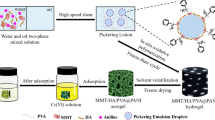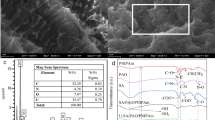Abstract
In this study, poly(acrylic acid-co-acrylamide) (PAAAM) hydrogels were used to remove uranium (VI) ions in wastewater and characterized by FTIR, SEM, EDX. The effects of pH value, coexistence of ionic strength, contact time, initial U (VI) ion concentration and adsorption temperature were also studied. Adsorption data fitted well with pseudo-second-order, intra-particle diffusion model and Langmuir isotherm mode, the maximum adsorption capacity of U(VI) was 713.24 mg g−1. Thermodynamic analysis shows that the adsorption of U(VI) is spontaneous endothermic. PAAAM hydrogel has excellent regeneration performance, after five time adsorption–desorption cycles, the adsorbent still maintained 99.24% adsorption capacity.












Similar content being viewed by others
References
Azimi A, Azari A, Rezakazemi M, Ansarpour M (2017) Removal of heavy metals from industrial wastewaters: a review. Chembioeng Rev 4(1):37–59. https://doi.org/10.1002/cben.201600010
Jarup L (2003) Hazards of heavy metal contamination. Br Med Bull 68:167–182. https://doi.org/10.1093/bmb/ldg032
Smirnova DE, Starikov SV, Stegailov VV (2012) Interatomic potential for uranium in a wide range of pressures and temperatures (vol 24, 015702, 2012). J Phys. https://doi.org/10.1088/0953-8984/24/14/149501
Sadeghi S, Sheikhzadeh E (2009) Solid phase extraction using silica gel modified with murexide for preconcentration of uranium (VI) ions from water samples. J Hazard Mater 163(2–3):861–868. https://doi.org/10.1016/j.jhazmat.2008.07.053
Bleise A, Danesi PR, Burkart W (2003) Properties, use and health effects of depleted uranium (DU): a general overview. J Environ Radioact 64(2–3):93–112. https://doi.org/10.1016/s0265-931x(02)00041-3
Mellah A, Chegrouche S, Barkat M (2007) The precipitation of ammonium uranyl carbonate (AUC): thermodynamic and kinetic investigations. Hydrometallurgy 85(2–4):163–171. https://doi.org/10.1016/j.hydromet.2006.08.011
Kabay N, Demircioglu M, Yayli S, Gunay E, Yuksel M, Saglam M, Streat M (1998) Recovery of uranium from phosphoric acid solutions using chelating ion-exchange resins. Ind Eng Chem Res 37(5):1983–1990. https://doi.org/10.1021/ie970518k
Jung Y, Kimb S, Park S-J, Kim JM (2008) Application of polymer-modified nanoporous silica to adsorbents of uranyl ions. Colloids Surf A 313:162–166. https://doi.org/10.1016/j.colsurfa.2007.04.087
Wang G, Liu J, Wang X, Xie Z, Deng N (2009) Adsorption of uranium (VI) from aqueous solution onto cross-linked chitosan. J Hazard Mater 168(2–3):1053–1058. https://doi.org/10.1016/j.jhazmat.2009.02.157
Fuller CC, Bargar JR, Davis JA, Piana MJ (2002) Mechanisms of uranium interactions with hydroxyapatite: implications for groundwater remediation. Environ Sci Technol 36(2):158–165. https://doi.org/10.1021/es0108483
Zhao Y, Li J, Zhang S, Chen H, Shao D (2013) Efficient enrichment of uranium(VI) on amidoximated magnetite/graphene oxide composites. RSC Adv 3(41):18952–18959. https://doi.org/10.1039/c3ra42236d
Tsuruta T (2004) Cell-associated adsorption of thorium or uranium from aqueous system using various microorganisms. Water Air Soil Pollut 159(1–4):35–47. https://doi.org/10.1023/B:WATE.0000049190.05993.3b
Preetha CR, Gladis JM, Rao TP, Venkateswaran G (2006) Removal of toxic uranium from synthetic nuclear power reactor effluents using uranyl ion imprinted polymer particles. Environ Sci Technol 40(9):3070–3074. https://doi.org/10.1021/es052195m
Akkaya R, Ulusoy U (2008) Adsorptive features of chitosan entrapped in polyacrylamide hydrogel for Pb2 + , UO22 + , and Th4+. J Hazard Mater 151(2–3):380–388. https://doi.org/10.1016/j.jhazmat.2007.05.084
Liu Y, Cao X, Hua R, Wang Y, Liu Y, Pang C, Wang Y (2010) Selective adsorption of uranyl ion on ion-imprinted chitosan/PVA cross-linked hydrogel. Hydrometallurgy 104(2):150–155. https://doi.org/10.1016/j.hydromet.2010.05.009
Chellam S, Clifford DA (2002) Physical-chemical treatment of groundwater contaminated by leachate from surface disposal of uranium tailings. J Environ Eng ASCE 128(10):942–952. https://doi.org/10.1061/(asce)0733-9372(2002)128:10(942)
Hui B, Zhang Y, Ye L (2014) Preparation of PVA hydrogel beads and adsorption mechanism for advanced phosphate removal. Chem Eng J 235:207–214. https://doi.org/10.1016/j.cej.2013.09.045
Alvarez-Lorenzo C, Concheiro A (2002) Reversible adsorption by a pH- and temperature-sensitive acrylic hydrogel. J Controll Release 80(1–3):247–257. https://doi.org/10.1016/s0168-3659(02)00032-9
Kumar M, Tripathi BP, Shahi VK (2009) Crosslinked chitosan/polyvinyl alcohol blend beads for removal and recovery of Cd(II) from wastewater. J Hazard Mater 172(2–3):1041–1048. https://doi.org/10.1016/j.jhazmat.2009.07.108
Wang W-B, Huang D-J, Kang Y-R, Wang A-Q (2013) One-step in situ fabrication of a granular semi-IPN hydrogel based on chitosan and gelatin for fast and efficient adsorption of Cu2 + ion. Colloids Surf B 106:51–59. https://doi.org/10.1016/j.colsurfb.2013.01.030
Liu Y, Wang W, Wang A (2010) Adsorption of lead ions from aqueous solution by using carboxymethyl cellulose-g-poly (acrylic acid)/attapulgite hydrogel composites. Desalination 259(1–3):258–264. https://doi.org/10.1016/j.desal.2010.03.039
Mittal H, Maity A, Ray SS (2015) The adsorption of Pb2 + and Cu2 + onto gum ghatti-grafted poly(acrylamide-co-acrylonitrile) biodegradable hydrogel: isotherms and kinetic models. J Phys Chem B 119(5):2026–2039. https://doi.org/10.1021/jp5090857
Liu T, Duan G, Duan X, Wu W, Yang Y (2013) Adsorptive features of polyacrylic acid hydrogel for UO2 (2 +). J Radioanal Nucl Chem 297(1):119–125. https://doi.org/10.1007/s10967-012-2316-7
Yi X, Xu Z, Liu Y, Guo X, Ou M, Xu X (2017) Highly efficient removal of uranium(VI) from wastewater by polyacrylic acid hydrogels. RSC Adv 7(11):6278–6287. https://doi.org/10.1039/c6ra26846c
Li S, Zhang H, Feng J, Xu R, Liu X (2011) Facile preparation of poly(acrylic acid-acrylamide) hydrogels by frontal polymerization and their use in removal of cationic dyes from aqueous solution. Desalination 280(1–3):95–102. https://doi.org/10.1016/j.desal.2011.06.056
Xie J, Liu X, Liang J (2007) Absorbency and adsorption poly(acrylic acid-co-acrylamide) hydrogel. J Appl Polym Sci 106(3):1606–1613. https://doi.org/10.1002/app.26666
Zhang S, Shu X, Zhou Y, Huang L, Hua D (2014) Highly efficient removal of uranium (VI) from aqueous solutions using poly(acrylic acid)-functionalized microspheres. Chem Eng J 253:55–62. https://doi.org/10.1016/j.cej.2014.05.036
Repo E, Warchol JK, Kurniawan TA, Sillanpaa MET (2010) Adsorption of Co(II) and Ni(II) by EDTA- and/or DTPA-modified chitosan: kinetic and equilibrium modeling. Chem Eng J 161(1–2):73–82. https://doi.org/10.1016/j.cej.2010.04.030
Chen Z, Wang J, Pu Z, Zhao Y, Jia D, Chen H, Wen T, Hu B, Alsaedi A, Hayat T, Wang X (2017) Synthesis of magnetic Fe3O4/CFA composites for the efficient removal of U(VI) from wastewater. Chem Eng J 320:448–457. https://doi.org/10.1016/j.cej.2017.03.074
Ho YS, McKay G (1999) Pseudo-second order model for sorption processes. Process Biochem 34(5):451–465. https://doi.org/10.1016/s0032-9592(98)00112-5
Orozco-Guareno E, Santiago-Gutierrez F, Luis Moran-Quiroz J, Hernandez-Olmos SL, Soto V, de la Cruz W, Manriquez R, Gomez-Salazar S (2010) Removal of Cu(II) ions from aqueous streams using poly(acrylic acid-co-acrylamide) hydrogels. J Colloid Interface Sci 349(2):583–593. https://doi.org/10.1016/j.jcis.2010.05.048
Wu FC, Tseng RL, Juang RS (2005) Comparisons of porous and adsorption properties of carbons activated by steam and KOH. J Colloid Interface Sci 283(1):49–56. https://doi.org/10.1016/j.jcis.2004.08.037
Horsfall Jnr M, Vicente JL (2007) Kinetic study of liquid-phase adsorptive removal of heavy metal ions by almond tree (Terminalia catappa L.) leaves waste. Bull Chem Soc Ethiopia 21(3):349–362
Monier M, Ayad DM, Wei Y, Sarhan AA (2010) Adsorption of Cu(II), Co(II), and Ni(II) ions by modified magnetic chitosan chelating resin. J Hazard Mater 177(1–3):962–970. https://doi.org/10.1016/j.jhazmat.2010.01.012
Li R, Liu L, Yang F (2014) Removal of aqueous Hg(II) and Cr(VI) using phytic acid doped polyaniline/cellulose acetate composite membrane. J Hazard Mater 280:20–30. https://doi.org/10.1016/j.jhazmat.2014.07.052
Wang J-S, Peng R-T, Yang J-H, Liu Y-C, Hu X-J (2011) Preparation of ethylenediamine-modified magnetic chitosan complex for adsorption of uranyl ions. Carbohydr Polym 84(3):1169–1175. https://doi.org/10.1016/j.carbpol.2011.01.007
Solener M, Tunali S, Ozcan AS, Ozcan A, Gedikbey T (2008) Adsorption characteristics of lead(II) ions onto the clay/poly(methoxyethyl)acrylamide (PMEA) composite from aqueous solutions. Desalination 223(1–3):308–322. https://doi.org/10.1016/j.desal.2007.01.221
Raji C, Anirudhan TS (1998) Batch Cr(VI) removal by polyacrylamide-grafted sawdust: kinetics and thermodynamics. Water Res 32(12):3772–3780. https://doi.org/10.1016/s0043-1354(98)00150-x
Liu Y (2009) Is the free energy change of adsorption correctly calculated? J Chem Eng Data 54(7):1981–1985. https://doi.org/10.1021/.je800661q
Bhattacharyya R, Ray SK, Mandal B (2013) A systematic method of synthesizing composite superabsorbent hydrogels from crosslink copolymer for removal of textile dyes from water. J Ind Eng Chem 19(4):1191–1203. https://doi.org/10.1016/j.jiec.2012.12.017
Akkas P, Güven O (2000) Enhancement of uranyl ion uptake by prestructuring of acrylamide-maleic acid hydrogels. J Appl Polym Sci 78(2):284–289. https://doi.org/10.1002/1097-4628(20001010)78:2<284:aid-app70>3.0.co;2-9
Raj L, Chauhan GS (2009) Uranyl ions uptake on poly(AAc/AAm)-cl-N,N-MBAAm hydrogel. Polym Bull 64(4):363–374. https://doi.org/10.1007/s00289-009-0183-3
He W, Chen Y, Zhang W, Hu C, Wang J, Wang P (2015) Removal of UO 2 2 + from aqueous solution using halloysite nanotube-Fe3O4 composite. Kor J Chem Eng 33(1):170–177. https://doi.org/10.1007/s11814-015-0111-1
Zare F, Ghaedi M, Daneshfar A, Agarwal S, Tyagi I, Saleh TA, Gupta VK (2015) Efficient removal of radioactive uranium from solvent phase using AgOH–MWCNTs nanoparticles: kinetic and thermodynamic study. Chem Eng J 273:296–306. https://doi.org/10.1016/j.cej.2015.03.002
Z-j Yi, Yao J, Wang F, H-l Chen, Liu H-j YuC (2012) Removal of uranium(VI) from aqueous solution by apricot shell activated carbon. J Radioanal Nucl Chem 295(3):2029–2034. https://doi.org/10.1007/s10967-012-2277-x
Author information
Authors and Affiliations
Corresponding author
Rights and permissions
About this article
Cite this article
Wei, C., Yang, M., Guo, Y. et al. Highly efficient removal of uranium(VI) from aqueous solutions by poly(acrylic acid-co-acrylamide) hydrogels. J Radioanal Nucl Chem 315, 211–221 (2018). https://doi.org/10.1007/s10967-017-5653-8
Received:
Published:
Issue Date:
DOI: https://doi.org/10.1007/s10967-017-5653-8




